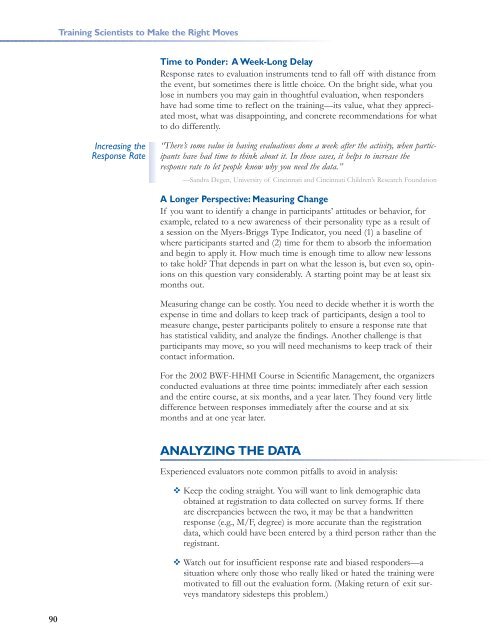Training Scientists to Make the Right Moves - Howard Hughes ...
Training Scientists to Make the Right Moves - Howard Hughes ...
Training Scientists to Make the Right Moves - Howard Hughes ...
Create successful ePaper yourself
Turn your PDF publications into a flip-book with our unique Google optimized e-Paper software.
<strong>Training</strong> <strong>Scientists</strong> <strong>to</strong> <strong>Make</strong> <strong>the</strong> <strong>Right</strong> <strong>Moves</strong><br />
Time <strong>to</strong> Ponder: A Week-Long Delay<br />
Response rates <strong>to</strong> evaluation instruments tend <strong>to</strong> fall off with distance from<br />
<strong>the</strong> event, but sometimes <strong>the</strong>re is little choice. On <strong>the</strong> bright side, what you<br />
lose in numbers you may gain in thoughtful evaluation, when responders<br />
have had some time <strong>to</strong> reflect on <strong>the</strong> training—its value, what <strong>the</strong>y appreciated<br />
most, what was disappointing, and concrete recommendations for what<br />
<strong>to</strong> do differently.<br />
Increasing <strong>the</strong><br />
Response Rate<br />
“There’s some value in having evaluations done a week after <strong>the</strong> activity, when participants<br />
have had time <strong>to</strong> think about it. In those cases, it helps <strong>to</strong> increase <strong>the</strong><br />
response rate <strong>to</strong> let people know why you need <strong>the</strong> data.”<br />
—Sandra Degen, University of Cincinnati and Cincinnati Children’s Research Foundation<br />
A Longer Perspective: Measuring Change<br />
If you want <strong>to</strong> identify a change in participants’ attitudes or behavior, for<br />
example, related <strong>to</strong> a new awareness of <strong>the</strong>ir personality type as a result of<br />
a session on <strong>the</strong> Myers-Briggs Type Indica<strong>to</strong>r, you need (1) a baseline of<br />
where participants started and (2) time for <strong>the</strong>m <strong>to</strong> absorb <strong>the</strong> information<br />
and begin <strong>to</strong> apply it. How much time is enough time <strong>to</strong> allow new lessons<br />
<strong>to</strong> take hold? That depends in part on what <strong>the</strong> lesson is, but even so, opinions<br />
on this question vary considerably. A starting point may be at least six<br />
months out.<br />
Measuring change can be costly. You need <strong>to</strong> decide whe<strong>the</strong>r it is worth <strong>the</strong><br />
expense in time and dollars <strong>to</strong> keep track of participants, design a <strong>to</strong>ol <strong>to</strong><br />
measure change, pester participants politely <strong>to</strong> ensure a response rate that<br />
has statistical validity, and analyze <strong>the</strong> findings. Ano<strong>the</strong>r challenge is that<br />
participants may move, so you will need mechanisms <strong>to</strong> keep track of <strong>the</strong>ir<br />
contact information.<br />
For <strong>the</strong> 2002 BWF-HHMI Course in Scientific Management, <strong>the</strong> organizers<br />
conducted evaluations at three time points: immediately after each session<br />
and <strong>the</strong> entire course, at six months, and a year later. They found very little<br />
difference between responses immediately after <strong>the</strong> course and at six<br />
months and at one year later.<br />
ANALYZING THE DATA<br />
Experienced evalua<strong>to</strong>rs note common pitfalls <strong>to</strong> avoid in analysis:<br />
Keep <strong>the</strong> coding straight. You will want <strong>to</strong> link demographic data<br />
obtained at registration <strong>to</strong> data collected on survey forms. If <strong>the</strong>re<br />
are discrepancies between <strong>the</strong> two, it may be that a handwritten<br />
response (e.g., M/F, degree) is more accurate than <strong>the</strong> registration<br />
data, which could have been entered by a third person ra<strong>the</strong>r than <strong>the</strong><br />
registrant.<br />
Watch out for insufficient response rate and biased responders—a<br />
situation where only those who really liked or hated <strong>the</strong> training were<br />
motivated <strong>to</strong> fill out <strong>the</strong> evaluation form. (Making return of exit surveys<br />
manda<strong>to</strong>ry sidesteps this problem.)<br />
90
















